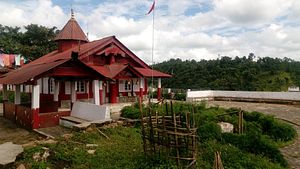In Nartiang, a little village deep inside the West Jaintia hills in the northeastern state of Meghalaya in India, there is a temple dedicated to the Hindu Goddess Durga. The temple not very popular outside of the state. Built during the time of the Hindu Jaintia kings about 500 years ago, the temple belongs to everyone in the hills and the mode of worship has been very specific to the Jaintia traditions of the area. It is a beautiful amalgamation of tribal Jaintia and Hindu customs. In recent years, however, activists have started getting worried about the Hindutva-ization of the temple and its customs, creating confusion and tension among the local population, which consists of Hindus and the people who follow traditional Jaintia customs, called Niyam Tre.
According to Hindu mythology, the God Shiva’s wife, Sati, got angry with her father for not inviting her husband to a religious function he was hosting. Furious at this disrespect, she immolates herself. When Shiva discovers that his wife was dead, he loses his mind and, with her corpse in his hands, starts a Tandava dance, leading to destruction everywhere. To control him, Vishnu severs the corpse and the places where Sati’s body parts fell are worshiped as Shakti Peeth. Nartiang is one of these Shakti Peeth sites and it is said that Sati’s left thigh fell here.
According to Shobhan Lamare’s book Studies in Society and Change: The Jaintias, “it was around the time of powerful king of the Jaintias Bijoy Manik (1548 – 1564), who followed the policy of war and subjugation that Brahmnical cult made a steady on roads to the hills and he consolidated his rule in the plains.” Lamare teaches history at the North-Eastern Hill University (NEHU), and is considered an authority on Nartiang and Jaintias. He goes on to say that “the influence of Hinduism had a significant impact on the Pnar (Jaintia) culture. The life of the people was transformed gradually, but the tradition of the people did not wane out with this kind of assimilation.”
It is exactly this beautiful culture of assimilation that is at stake now. In spite of an origin deeply embedded in Hindu mythology, the temple belongs to everyone who lives here. The village is also one of the small pockets of Hindus in this Christian-majority state. The Jaintia king had built the palace and temple in the typical Jaintia style of architecture. The entrance gate is still well-preserved. The old palace of the Jaintia king wasn’t so lucky; there is a government building over the remains of the palace. According to Lamare, the style of worship is very typical to Jaintia customs and the biggest festival at the temple is Durga Puja (a festival to celebrate Durga), celebrated for only three days. At the end of three days, a bamboo effigy of the Godess Durga is immersed in the Myntang River that flows through the village.
Lamare isn’t aware of Hindutva-ization of the temple and says the Durga Puja is still celebrated in the traditional style only. But some activists have pictures of random sadhus (roving holy men) going there and holding a yagya (a form of Hindu worship) at regular intervals. The temple itself has been rebuilt by the Ramakrishna Mission, thankfully following the exact same model of the old temple. It is also alleged that the sadhus who come here perform Tantric ceremonies, thought to be a form of black magic.
The temple and Shakti Peeth in general were known for human sacrifices back in the day too, which were banned by the British when they came to the subcontinent. In his book, Lamare writes how the influence of Hinduism lead to a deeper philosophical engagement with religion in the region. But totally changing the character of the temple is a cause of worry. Recently, there was tension over the issue of who would be the priest after the death of the two brothers who belonged to the state of Maharashtra’s Deshmukh clan and had served the temple for generations.
According to various news reports, the village head, supported by people from the Ramakrishna Mission, wanted to introduce a new priest, instead of Deshmukh’s son, who is also born of a Pnar woman. The local women blocked the temple and didn’t let the new priest enter. This incident even reached the high court of the state. Currently, Deshmukh’s youngest son looks after the temple.
In this environment, it would seem advisable to limit any interference with the old temple. These issues are becoming increasingly problematic in today’s India.

































